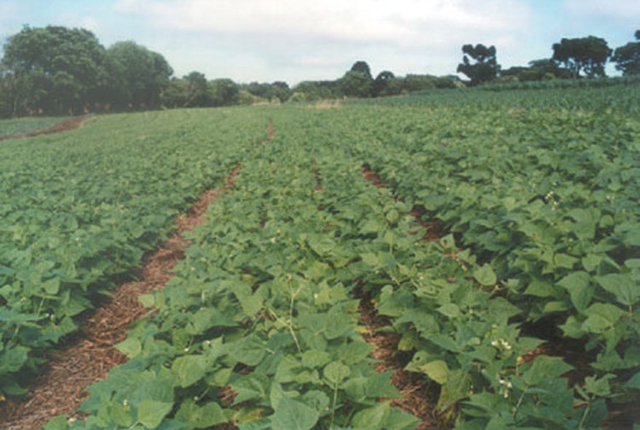Farmers should engage in conservation agriculture


Conservation agriculture involves minimum soil disturbance, surface cover through use of crop residues and diverse crop rotations and associations
Brenda Ziga : Features Correspondent
Erratic rainfall and high input costs continue to hamper agricultural production. The challenges have had a negative impact on Zimbabwe’s status as the bread basket of the Southern African region. Innovation and research has however heightened prospects of overcoming these challenges. Zimbabwean farmers now look at techniques such as conservation agriculture as a solution to some of these challenges.Conservation agriculture has been embraced by farmers who have testified to the good yields enjoyed from the practice.
Mr Tedios Mhishi has ditched conventional farming methods relying on locally available resources.
With minimum tillage involved in conservation agriculture, Mr Mhishi from Murehwa district in Mashonaland East, has reduced his costs while producing more from his fields.
He had, in 2009, struggled to fund his agricultural activities before turning to conservation agriculture.
“The farming method has turned out to be a blessing leading to improved yields,” he said during a tour of his fields organised by Gwebi Agricultural College.
“I used to get below a tonne per hectare and this was normal in my area especially during dry periods but I harvest more than three tonnes per hectare now.”
Mr Mhishi has had a bumper harvest despite the difficulties from the El Nino induced drought experienced during the summer cropping season.
He has even diversified into forage agriculture growing velvet beans and Lab lab used in preparing livestock feeds.
Lab lab is a summer-growing annual or occasionally short-lived perennial forage legume.
Conservation agriculture involves minimum soil disturbance, surface cover through use of crop residues and diverse crop rotations and associations.
Guruve farmer Mr Takawira Magomo is happy to have taken up conservation agriculture last season realising an unexpected yield.
“I got 10 bags of maize from a 0.3 hectare piece of land with prospects for a higher yield,” he said.
Shamva farmer Mr Lazarus Fuwa said the use of crop residue has reduced the amount of fertilisers for cropping.
“The need for fertilisers has been reduced significantly over the past seasons due to nutrient build up in the conservation agriculture planting basins.
“I started practising conservation agriculture in 2008 and I can confidently reveal how agricultural production has helped me improve my life,” he said.
Midia Chikomo from Mutoko believes conservation agriculture is not as laborious as compared to conventional agricultural method.
“The use of the basins when planting maize maintains a permanent set of planting holes that are used every year.
Gwebi Agricultural College principal Dr William Matizha said communities that have been engaged in conservation agriculture have improved their yields and ensured food security at household level.
He said his institution was working on promoting conservation agriculture across Zimbabwe.
“We want the message of conservation to get to the land users particularly following land reform programme,” he said.
“We have upped the tempo in training resettled farmers to sustainably utilise their farms.”
He said: “Climatic changes mean we have to come up with farming methods that do not only conserve environment but also cope with it.”
Dr Matizha said farmers were not getting expected yields through conventional farming methods hence the need to engage in conservation agriculture. Mashonaland Central Zimbabwe Farmers Union provincial manager Mr Tapiwa Nyamakura said farmers should take up conservation farming to fight effects of climate change.
“Conservation agriculture has proven to improve production levels of farmers on small areas especially in communal areas,” he said.
He hailed the private sector in Zimbabwe for coming up with implements used in conservation agriculture.
“We are, however, appealing for the manufacturing industry to make these implements accessible and affordable to communal farmers,” he said.
Mr Nyamakura said conservation agriculture can help farmers change their livelihoods.
“Farmers can better their livelihoods with improved diet and income generation through the adoption of conservation agriculture,” he said.
According to the Food and Agriculture Organisation, conservation agriculture principles are universally applicable to all agricultural landscapes and land uses with locally adapted practices.
“CA enhances biodiversity and natural biological processes above and below the ground surface.
“Soil interventions such as mechanical soil disturbance are reduced to an absolute minimum or avoided, and external inputs such as agrochemicals and plant nutrients of mineral or organic origin are applied optimally and in ways and quantities that do not interfere with, or disrupt, the biological processes.”
FAO also acknowledges that it facilitates good agronomy, such as timely operations, and improves overall land husbandry for rain-fed and irrigated production.
Complemented by other known good practices, including the use of quality seeds, and integrated pest, nutrient, weed and water management, CA is a base for sustainable agricultural production intensification.
“It opens increased options for integration of production sectors, such as crop-livestock integration and the integration of trees and pastures into agricultural landscapes.”
Zimbabwe needs at 2,2 million tonnes of maize for both human and livestock consumption.
The country also needs about 1,3 million tonnes of maize from February until the end of the year.
Zimbabwe has more than 100 000 tonnes available in the Strategic Grain Reserve while more than 60 000 tonnes have already been distributed under the drought mitigation programme.
Conservation agriculture can be used in most drought-hit areas such Matabeleland South, Midlands, Masvingo and southern Manicaland.
According to Government’s economic blueprint, ZimAsset’s Food Security and Nutrition Cluster, Zimbabwe should be a self-sufficient and food surplus economy and re-emerging as the “bread basket of Southern-Africa”.
The cluster seeks to ultimately build a prosperous, diverse and competitive food security and nutrition sector that contributes significantly to national development through the provision of an enabling environment for sustainable economic empowerment and social transformation.
The cluster programmes are aligned to and informed by the Comprehensive African Agricultural Development Programme (CAADP), Draft Comprehensive Agriculture Policy Framework (2012-2032), the Food and Nutrition Security Policy, the Zimbabwe Agriculture Investment Plan (2013-2017), SADC and COMESA Food and Nutrition Frameworks.
Feedback: [email protected]










Comments